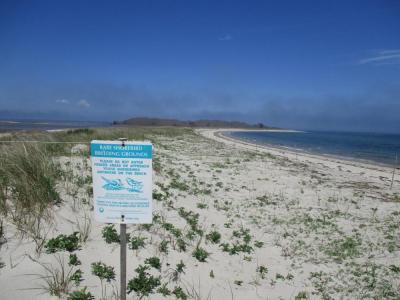Wind and wave action are natural processes, and that wild stretch of weather increased sandy habitat and carrying capacity of pairs on West Island Town Beach. While the estimated 4-5 pairs isn’t an increase in abundance, the replenished berm drew interest from un-nested, or birds losing nests at other sites. Ultimately the high tides and human passage along the beach still forced most pairs into dune areas, with only one pair thus far nesting down on the sand. Although no pairs have nested thus far on the spit near the town lot, the spit there increased in size due to the winds, to the delight of the large terns (Roseate and Common) that nest on the Elizabeth Island Chain. Small flocks usually seen in August are already roosting and feeding on the spit and a plover or Least Tern nest (and some fencing) on this small sliver of sand can’t be ruled out.
Following a season of total nests loss, predation rates are again high on an island where a population of other wildlife is well established. Animals such as foxes and coyotes have found well-hidden nests thus far, but have spared nests in the open. With predator stress and nest loss rate high, the first predator exclosure was installed on the beach. With a long season ahead, we remain hopeful for some hatchlings to appear on the town beach and island overall. At Winsegansett Heights, monitored in conjunction with the island, both a plover and oystercatcher nest occurred, but were lost to predation and overwash, respectively.
For our smaller sites, at Bakers Beach for the first time in recent memory, the first nest was not from the parking lot pair, but the pair utilizing the adjacent dune bowl. The nest is going strong with hopes of a hatch in a couple weeks. At long last, the lot pair laid its first egg on May 25, with a projected hatch date near the fourth of July weekend, surely to be an exciting yet challenging situation for all. And a pair has returned to New Bedford’s East Beach, where we are providing assistance to the city for the protection of a pair in an urban environment.
On other avian fronts, the osprey nesting is also well underway, with each of the four platforms we oversee currently active. On the Slocum River, each platform across the river has 2 eggs, while the platforms near the Lloyd Center pier and on Little River off the Lloyd Woods property both have three. We’ll check again next month for a hatchling count, then once more in July, in hopes of a banding session in collaboration with MA Audubon.
Finally, as the intensive work on shorebird nesting season kicks in and our weekly bird walks in the forest come to a close, we thank those who attended and remember all the neat sightings, ranging from raptors to migrant warblers. But the rare Red-headed Woodpecker, which we suspect may have departed with other migrants to find a mate, won’t soon be forgotten as the bird of the year on our property. If the bird has indeed left we wish it well, hope it has many babies, and sends its offspring our way in the fall.
Stay tuned later in the season for another update as to how the season shaped up!
by Jamie Bogart, Lloyd Center Research Associate














